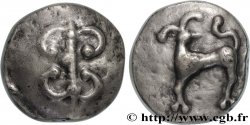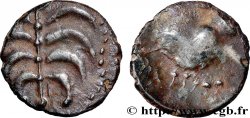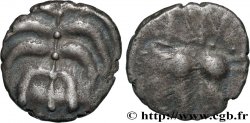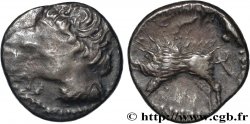v15_1370 - HELVETI (Current Switzerland) Statère de Philippe II, imitation celtique
MONNAIES 15 (2002)
Начальная цена : 950.00 €
Назначить цену : 2 000.00 €
Цена реализации : 950.00 €
Начальная цена : 950.00 €
Назначить цену : 2 000.00 €
Цена реализации : 950.00 €
Тип Statère de Philippe II, imitation celtique
Дата: IIe-Ier siècles avant J.-C.
Металл: gold
Диаметр: 18 mm
Ориентация осей монеты: 1 h.
Вес: 7,96 g.
Редкость: R3
Комментарии о состоянии
Exemplaire sans frai apparent mais recouvert de stries, au droit et au revers, qui font fuser les reliefs. Plusieurs imperfections de frappe. Frappe faible au revers et coup ou paille de métal sur l’aurige
Лицевая сторона
Аверс: легенда: ANÉPIGRAPHE.
Аверс: описание: Tête laurée à droite, imitant la tête d’Apollon.
Обратная сторона
Реверс: Описание: Bige galopant à droite, les chevaux bondissant, avec un objet indéterminé sous les pattes avant. L'aurige, au-dessus de la roue du char, tient un fouet. Traces de légende, mais pas de ligne d’exergue.
Реверс: легенда: [fILIPP.U].
Комментарий
Ce statère dont le revers est difficilement lisible semblerait appartenir à l’émission AP, foudre et épi. Comme sur l’exemplaire du musée de Lyon (Sch/L. 300), on semble distinguer un trait qui s’arrête au menton avec un motif décoratif au milieu du cou en forme de boucle. Au revers, tous les symboles semblent comme absents, fortement martelés ou flous. Un trait semble barrer l’arrière de la nacelle du char. Notre exemplaire, avec un poids léger, n’est pas incompatible avec la série car l’exemplaire du musée de Luxembourg ne pèse pas plus (7,96 g). Notre exemplaire n’est pas sans présenter une homotypie de contiguïté avec le type des statères décrits par Allen (RSN. 1974, pl. II, n° 36-37 qui présentent la particularité d’avoir le visage barré d’un trait et qui sont réputés provenir de la trouvaille de Craon dans la Mayenne. Le statère de Philippe II, ayant reçu un coup de cisaille afin de le démonétiser (cf. Musée de Clermont-Ferrand, p. 23, n° 983-18-1, LT. 6410) est réputé avoir été trouvé dans les environs de Chartres. L’attribution aux Helvètes est possible, mais pas certaine, pas plus que celle aux Arvernes ou bien encore une hypothétique attribution aux Carnutes.








 Cообщить об ошибке
Cообщить об ошибке Распечатать страницу
Распечатать страницу Отправить мой выбор
Отправить мой выбор Задать вопрос
Задать вопрос Consign / sell
Consign / sell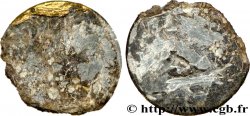
 Информация
Информация